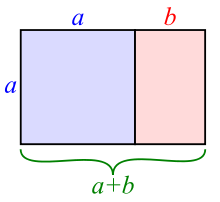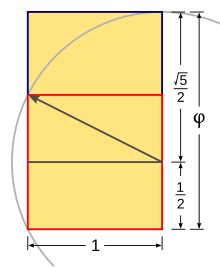Golden rectangle

In geometry, a golden rectangle is a rectangle whose side lengths are in the golden ratio, , which is (the Greek letter phi), where is approximately 1.618.
Golden rectangles exhibit a special form of self-similarity: All rectangles created by adding a square to a side, or removing a square from an end, of a golden rectangle are golden rectangles as well.

Construction
A golden rectangle can be constructed with only a straightedge and compass in four steps:
- Drawing a square
- Drawing a line from the midpoint of one side of the square to an opposite corner
- Using that line as the radius to draw an arc that defines the height of the rectangle
- Completing the golden rectangle
A distinctive feature of this shape is that when a
History
The proportions of the golden rectangle have been observed as early as the
According to Livio, since the publication of Luca Pacioli's Divina proportione in 1509, "the Golden Ratio started to become available to artists in theoretical treatises that were not overly mathematical, that they could actually use."[6]
The 1927 Villa Stein designed by Le Corbusier, some of whose architecture utilizes the golden ratio, features dimensions that closely approximate golden rectangles.[7]
Relation to regular polygons and polyhedra
The convex hull of two opposite edges of a regular icosahedron forms a golden rectangle. The twelve vertices of the icosahedron can be decomposed in this way into three mutually-perpendicular golden rectangles, whose boundaries are linked in the pattern of the Borromean rings.[9]
See also
- Fibonacci number– Numbers obtained by adding the two previous ones
- Golden angle -- Circle with sectors in golden ratio
- Golden rhombus – Rhombus with diagonals in the golden ratio
- Kepler triangle – Right triangle related to the golden ratio
- Silver ratio – Ratio of numbers, approximately 1:2.4
- Plastic ratio – Algebraic number, approximately 1.3247
- Supergolden ratio – Algebraic integer, approximately 1.46557
- Rabatment of the rectangle – Cutting a square from a rectangle
Notes
References
- ISBN 9-781-61614-424-1.
- ISBN 0-7679-0816-3.
- ISBN 978-1-904263-47-0.
- ^ Van Mersbergen, Audrey M., Rhetorical Prototypes in Architecture: Measuring the Acropolis with a Philosophical Polemic, Communication Quarterly, Vol. 46, 1998 ("a 'Golden Rectangle' has a ratio of the length of its sides equal to 1:1.61803+. The Parthenon is of these dimensions.")
- ^ Livio, Mario. "The Golden Ratio in Art: Drawing heavily from The Golden Ratio" (PDF). p. 6. Retrieved 11 September 2019.
- ISBN 0-7679-0816-3.
- ISBN 0-419-22780-6: "Both the paintings and the architectural designs make use of the golden section".
- ^ Euclid, Euclid's Elements|Elements, Book XIII, Proposition 10.
- ISBN 9781931914413..
External links
- Weisstein, Eric W. "Golden Rectangle". MathWorld.
- Weisstein, Eric W. "Golden Ratio". MathWorld.
- The Golden Mean and the Physics of Aesthetics
- Golden rectangle demonstration With interactive animation
- From golden rectangle to golden quadrilaterals Explores some different possible golden quadrilaterals







